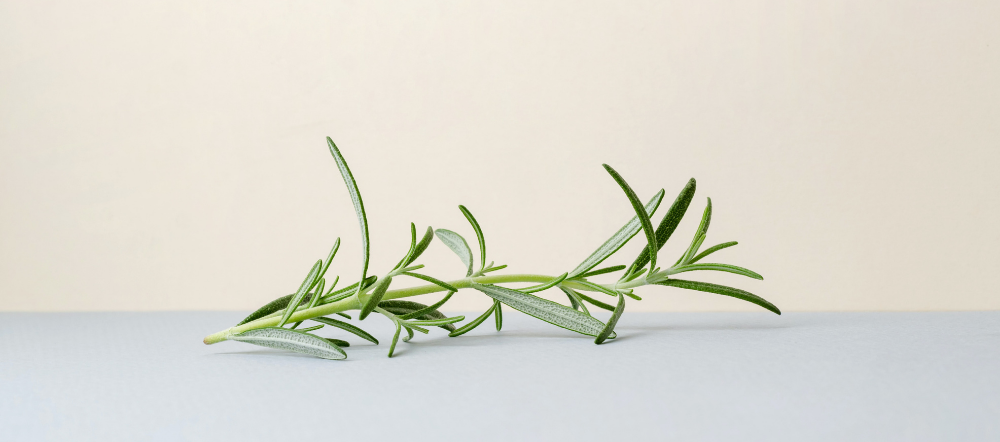Rosemary is a very popular herb, known for its distinctive taste, its ability to enhance the flavor of many foods, and its strong aroma. It is also a very popular herb for ornamental reasons — in many areas, it can grow as a perennial and add an “evergreen” piece to landscapes.
You’ve likely used this herb while cooking before, or at least ate a dish that included rosemary. It’s often used in common dishes like soups, casseroles, and salad. Around Thanksgiving its often used with turkey, chicken, and other seasonal meats.

So how do you start growing rosemary from cuttings? While growing rosemary from seed is certainly an option, growing rosemary from cuttings can be an interesting experience and doesn’t even require you to own a rosemary plant.
Can rosemary be grown from cuttings?
Yes, rosemary can be grown with cuttings, also known as propagating rosemary. Propagating simply means producing a plant that is identical (genetically speaking) to its parent by means of dividing, taking cuttings, etc. It’s essentially cloning your plant!
Some plants are more difficult to propagate than others, but with rosemary, a little patience and plant care will result in your very own little rosemary bush!
Today, we’ll discuss how to grow rosemary from cuttings.
How to grow rosemary from cuttings
To grow rosemary from cuttings, you’ll need:
- A small pot (3″ in diameter is good, with drainage) or growing area with some potting soil
- Water
- Rooting hormone (optional)
Before we get into the specific steps, it should be noted that growing rosemary from cuttings is a lengthy process. Depending on the strategy taken, it could take as long as a year until you can harvest and eat from your new rosemary plant.
Step-by-step on how to propagate rosemary
Here’s a rundown of everything involved with growing rosemary from cuttings.
1. Get a hold of some rosemary
To start, you’ll need some rosemary cuttings, of course.
If you are growing your own rosemary, simply cutting off some healthy, non-flowering sprigs of rosemary will do. No need to cut off full branches — sprigs that are anywhere from 5-10″ long will be great!
You can take cuttings any time throughout the growing season, but the best time is in the summer or spring when the stems are not as woody.
Quick tip: new roots are most likely to grow from the rosemary plant’s “nodes” which are the joints where new leaves grow out of the stem. These nodes hold growth hormones that initiate root growth. Make sure to cut just beneath one of these nodes for the best chance at propagating.
If you aren’t currently growing rosemary and don’t know of anyone who is willing to share theirs, most grocery stores or farmers markets sell packs or bunches of fresh rosemary. While its certainly more preferable to cut sprigs straight from a plant, some fresh sprigs of rosemary that is purchased should be fine to get started.
So, when is the best time to plant? While the answer will vary depending on where you are growing, generally early spring or summer is optimal. The stem of the rosemary plant will be less woody this time of year, which will make it easier for roots to grow out of it.

2. Strip leaves off bottom 2″ of the rosemary sprig
Once you have a rosemary sprig, strip off the leaves on the lower end of the stem — you’ll want about 2″ – 4″ of bare stem, which will serve as the base for future roots!
Rosemary is easy to strip leaves off of. Simply press your two index finger and thumb around the stem and pull down to strip the leaves.
Due to rosemary’s woody stems, some growers also will strip the outer skin of the stem off with a knife.
If you are ready to propagate the sprig right away, cut the tip of the sprig at a 45-degree angle. This will ensure some fresh exposure to the center of the sprig.
If you aren’t ready to propagate, you can store the sprigs in your fridge, wrapped in a plastic bag.
3. [Optional] Dip the stem into a growth hormone
At this point, you have the option of dipping the sprig’s bare stem into a rooting hormone.
Using a growth hormone is optional, especially when it comes to rosemary, which you’ll likely be consuming down the road. In some cases, it may be necessary for healthier roots, but in many cases, you can get by without it.
If you do want to use a growth hormone for a faster and healthier root system, you can purchase either the powder or gel form at your local garden center. Then, simply dip your stem into some water and tip into the growth hormone.
When propagating rosemary with a rooting hormone, keep in mind that most hormones (whether in powder or gel form) will require you to wait until a full year before consuming any part of the plant.
4. Start the root structure
If you chose to start the plant with a growth hormone, you can plant the stem in a potting soil mix to ensure that is has good draining. Since these are just little sprigs at this point, planting the rosemary in a small pack or pot is preferable. This will allow you to move the plant around, if needed.
If you aren’t using a growth hormone, you’ll want to establish a root structure before planting in soil. To do this, you can place your rosemary plant in a glass of water, with the 2″ of bare stem fully submerged.
It’s recommended to swap the water out every week or so. After 10-15 days, you should start seeing your first roots emerging from the rosemary sprigs!
Wait to pull the rosemary sprigs from the water until there at least a dozen roots that are a few inches long.
Once you have some mature roots, the plant is ready to plant in potting soil! Make sure the sprig’s stem has good contact with the soil so that the root system can grow immediately into the soil.

5. Wait 6-8 weeks for maturing plant
Depending on what time you are propagating, the time it will take to root up and growing will vary. Typically, after 6-8 weeks you’ll start seeing some indicators of growth.
It’s best to store your rosemary plant in a warm, humid area. If you have a greenhouse, this climate is perfect! If not, you can achieve the same effect by putting a plastic bag over the plant and container. Depending on the outside climate that you are growing in, keeping the plant outside may be good enough.
It’s best to water your young rosemary plant once a day at this point. Once the plant matures, you won’t need to water it as much. Learn more about watering rosemary.
If you notice that the leaves start to turn yellow or brown/black after a few weeks, it may be due to transplant shock (much like us humans, plants don’t like sudden change). In this case, simply trim off the discolored leaves to prepare for more growth.
6. Care for your new rosemary plant
Now that you have your plant started, its time to start treating it like any young plant you would purchase at a greenhouse or growing center. Make sure the rosemary plant gets plenty of sunlight, water (keeping the top level of soil damp is great!) and care is going to be crucial.
Here’s more information on how often to water your herb plant.
Eventually, the rosemary plant will outgrow its original pot and you can plant this perennial directly in the ground for rosemary for years to come.

Summary
To summarize, rosemary is a great herb to try growing from cuttings. To propagate your rosemary, you can follow these steps:
- Get a hold of some rosemary (either from an existing plant or from your grocery store)
- Strip off leaves from each stem’s bottom 2″
- Dip the stem in a growth hormone and plant in potting soil (optional – see step 4 for the alternative option)
- Place the stem in a glass of water for a few weeks until mature roots have grown before planting
- Store the stem and pot in a humid climate and water occasionally for 6-8 weeks
- Care for your new rosemary plant!


